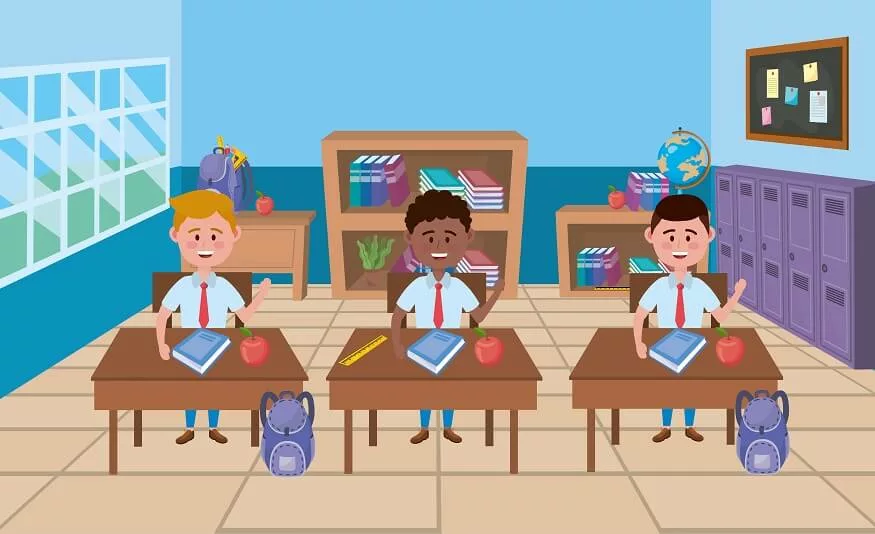Classroom etiquette is a fundamental cornerstone of any effective and harmonious learning environment. When we talk about classroom etiquette for students, we refer to the behavioural norms and standards that promote respect, courtesy, and effective learning. Just as societal manners dictate our behaviour in public settings, good manners in the classroom dictate the behaviour appropriate in an educational environment.
Also Read: Best Assessment for Learning Strategies and How to Make Them Work in Your Classroom
Classroom etiquette for students
Below are ten tips that emphasise classroom good manners. Adhering to these can make the classroom experience more rewarding for both students and educators.
- Punctuality is Paramount: One of the primary class manners for students is punctuality. Arriving on time demonstrates respect for the tutor and fellow students. It ensures you don’t miss out on essential introductory points and that you aren’t disturbing the class once it has begun.
- Active Listening: Good classroom etiquette involves more than just keeping quiet. Active listening requires that students are engaged and attentive. It means not only hearing but understanding and processing information. When you actively listen, you’re not only benefiting yourself but also showing respect to the speaker.
- Raise Your Hand to Speak: A classic yet essential piece of classroom etiquette for students is the act of raising one’s hand before speaking. It ensures that the classroom doesn’t descend into chaos with multiple people talking at once. Moreover, it displays respect for the current speaker and the overall classroom structure.
- Respect Everyone’s Opinion: Everyone is entitled to their viewpoint. When discussing topics, disagreements might arise. Classroom good manners dictate that you address these disagreements with respect and understanding. Personal attacks and dismissive comments are not conducive to a healthy learning environment.
- Keep Electronic Devices Silent: In this digital age, distractions are merely a notification away. As a part of class manners for students, ensure that all electronic devices are on silent or switched off. If you must use them for academic purposes, do so without disturbing others.
- Be Prepared: Good manners in the classroom also involve being prepared for each lesson. This means having all necessary materials, such as books, pens, and notebooks. When a student is unprepared, it can disrupt the flow of the class, causing delays and distractions.
- Clean Up After Yourself: A fundamental part of classroom etiquette is treating the classroom with respect. After each class, make sure your area is tidy. This not only creates a pleasant environment for the next class but also shows respect for those who will be using the room after you.
- Engage in Group Activities with Enthusiasm: Group activities are an integral part of learning. Engaging enthusiastically, even if the task isn’t one of your favourites, demonstrates good manners in the classroom. This teamwork fosters unity and makes the educational journey more interactive and fun.
- Avoid Side Conversations: Whispering or engaging in off-topic conversations can be incredibly distracting to others. Remember, classroom etiquette for students involves ensuring that everyone has the best learning experience possible. Save unrelated discussions for after the class.
- Show Appreciation: A simple ‘thank you’ can go a long way. Whether it’s directed at a teacher for explaining a challenging topic or a fellow student for sharing their notes, appreciation is an essential aspect of classroom good manners. It fosters a positive environment where everyone feels valued and respected.
Also Read: Classroom Management Strategies and Techniques
The Importance of Classroom Etiquette
Here’s why classroom etiquette is of paramount importance:
- Promotes Effective Learning: A well-mannered classroom, where students respect rules and each other, experiences fewer disruptions. This leads to more focused learning sessions, helping students grasp concepts more efficiently.
- Creates a Respectful Environment: Classroom etiquette promotes mutual respect. When students and teachers treat each other courteously, it fosters an environment where everyone feels valued. This mutual respect can enhance teacher-student relationships and facilitate better communication.
- Reduces Classroom Disruptions: Rules about speaking turns, mobile device usage, and punctuality minimise interruptions. Fewer disruptions mean the class can proceed smoothly, ensuring topics are covered comprehensively.
- Prepares Students for Real-world Interactions: The classroom is a microcosm of the larger world. The etiquette students practice in the classroom prepares them for future interactions in higher education, professional settings, and social situations.
- Boosts Confidence: When students are aware of classroom norms and expectations, it reduces anxiety and uncertainty about how to behave. This can enhance their confidence in participating, asking questions, and collaborating with peers.
- Encourages Active Participation: In a respectful classroom setting, students feel more comfortable sharing their views, asking questions, and participating in discussions. They are less fearful of ridicule or disrespect, leading to richer and more varied contributions from all students.
- Facilitates Group Work: Many educational strategies involve group work or teamwork. Classroom etiquette ensures that group interactions are harmonious, with each member respecting others’ ideas and contributing constructively.
- Supports Inclusivity: Proper classroom manners ensure that all students, irrespective of their background, beliefs, or abilities, are treated with respect and dignity. This inclusivity is crucial for creating an environment where every student feels welcomed and valued.
- Builds Character: Practising good manners in the classroom helps inculcate values like patience, respect, and humility in students. These values play a vital role in shaping students’ character and influencing their behaviour outside the classroom as well.
- Enhances Teacher Efficiency: When a teacher doesn’t have to constantly manage disruptions or disrespectful behaviour, they can focus on their primary job – teaching. An environment with strong classroom etiquette allows educators to be more effective and innovative in their teaching methods.
Also Read: Importance of Classroom Management Strategies
Classroom etiquette is not merely about adhering to a set of rules; it’s about cultivating a positive learning culture. Such an environment benefits not only the immediate classroom experience but also moulds students into respectful and considerate individuals in the broader world. Our EuroSchool is always evolving and our classrooms become more diverse and technology-driven, the principles of good classroom manners remain a constant, grounding force that ensures the sanctity and effectiveness of the learning environment.
Classroom etiquette isn’t merely a set of rigid rules; it’s a testament to the respect and value we give to education and those we share the learning journey with. By practising these ten tips, students can ensure a more conducive and harmonious classroom environment for all. Whether it’s showing up on time, listening actively, or merely cleaning up after oneself, every small act plays a part in creating a respectful and effective learning atmosphere.










